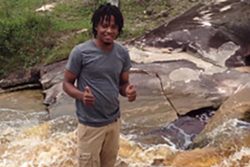Guyana’s first ever female drug rehabilitation centre was officially commissioned yesterday at a cost of over $20M at Mon Repos, East Coast Demerara.
It will however be another two weeks before women can access treatment, according to Clarence Young, head of the Phoenix Recovery Project, which will be manning the centre.
The centre has the capacity to accommodate 12 and Young said that they already have 11 on the waiting list.
For years calls have been made for a female drug rehabilitation centre to be established since such centres only existed for men.
The commissioning yesterday was made possible as a result of US$125,000 funding provided by the US State Department’s International Narcotics Legal Affairs Unit (INL) and Catholic Relief Services (CRS).
The INL’s funding amounts to some US$100,000, according to spokesperson for the US Embassy, Rolf Olson.
Describing the centre as something that is new and exciting in Guyana, head of CRS Thibaut Williams recalled that his organisation became interested in the project following a study commissioned by the Canadian International Development Agency (CIDA) and the health ministry last year January.
The study found that HIV prevalence among people who use illicit drugs was “alarmingly high” and highlighted a strong correlation between HIV and substance abuse.
That study, which was done by Young, involved some 172 persons who were interviewed and HIV tests conducted. The results showed that there was an overall HIV rate of 16.9%. Women in the study had an “astounding 52.9%” HIV rate. Out of the 172, 13% of the men were positive with some 53% of the females being positive, the study found.
Young had said then that when they started the study they had decided that if they found 2% of the persons were infected it would have been significant. However, they were all alarmed to find such a large number of persons infected. Interestingly, the study had said that 88% wanted addiction treatment; 19% actually received treatment; 62% said it was too costly to access treatment; 12% were unaware of treatment programmes and 20% actually had no desire to quit.
The study had also found that there was a need to develop a strategy to address HIV and substance abusers and this should include a broad-based, comprehensive response from a wide variety of stakeholders.
Further, it was also found that there was need for a public health response that would address the complex nature of HIV and substance use, while being flexible, appropriate and informative.
The response requires “addiction services that are prepared to respond to people in the varying stages of their substance use and can facilitate HIV prevention, testing, and treatment,” the study had said. Williams said that in Young he found a man who had a plan and they decided to work together.
Opening of the centre is not a one stop thing, according to Williams, since there are four components to the holistic programme they have planned – the centre being just one.
One of the components involves five pilot communities that would target youths in the area of substance abuse for an 18-month period. The second component of the project, which has already commenced, is the training of healthcare workers in an effort to assist them in dealing with substance abuse cases, which would see them referring persons who need help to rehabilitation centres. The project also involves a component which would see outreach programmes being conducted at the female prison in New Amsterdam and it would involve the counselling of those who are addicted to drugs. This part of the project has already commenced and it is hoped that support groups would be formed.
Substance abuse illness
Williams told those present that substance abuse is an ill in society that no one is immune from as everyone is affected somehow by the disease.
Meanwhile, Olsen said that substance abuse is a challenge that no country in the world can escape. He said they recognised that Guyana had a challenge on its hands in the absence of a rehabilitation centre for women and decided to come on board. Olsen expressed the hope that the centre makes a difference but noted that all must be involved in the fight as Guyana has shown through its fight against HIV/AIDS that success can come when all are involved.
Young recalled that he first came to Guyana in 1995 to conduct a three-week session with addicts even as he himself was a recovering addict but he was employed to conduct training sessions. He said his presence now arose out of a promise he made at that time to return. His promise came through when in April 1996 he became disgruntled with his job in his homeland, Trinidad and Tobago, and decided to pack up and head to Guyana.
He said he was called ‘mad’ for the second time in his life, the first being when he was hooked on drugs, as persons asked him how he would survive in Guyana with a loaf of bread costing $100.
But Young said his reality is that they are talking about human beings and he would always want to help, adding that there are men who have accessed treatment at his centre who have been clean for 11 years.
The new female drug rehab centre is equipped with five clinical staff, two cooks, two security guards and a chaplain. Women are expected to remain in the programme for six months.
Young said they are still appealing for corporate sponsorship, especially in the area of food for the inmates and for therapeutic material. Those willing to assist can contact the centre at 220-6825 and 623-1437.
Williams in an interview with this newspaper earlier this year had said that the funding would only provide services for 18 months and it is hoped that the centre would become self-sustaining after this period. (Oluatoyin Alleyne)





